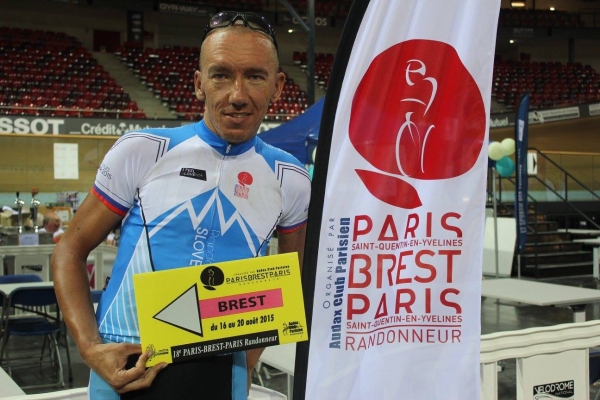The HISTORY of PBP:
Paris–Brest–Paris (PBP) was held for the first time in 1891 (12 years before the first Tour de France) and it was originally a 1200km bicycle race from Paris to Brest and back to Paris. It is the oldest bicycling event still regularly run – every 4 years. PBP starts on the NE side of Paris and it travels 600km to the city of Brest. The 90h time limit sees to it that only the well prepared cyclists earn the prestigious medal »PBP Finisher« and their place is written in a big book of those who finished the race from the first edition until today. From the beginning the race was meant for professional racers, but in the middle of 20. century in has developed into the »randonnee« or »brevet« with time measurement for the World's best cyclists amateurs.
In 1891 the Petit Journal organised the first Paris-Brest-Paris. Pierre Giffard, head of the newspaper, promoted the 1200km race to demonstrate the practicality of the bicycle. Cycles were sealed at the start to ensure riders used the same machine throughout and entries from foreign riders and women were refused. It was a real success judging by the over 400 registrants. 206 cyclists started on September 6th, including 10 tricycles, 2 tandems and an ordinary ridden by M. Duval. Both amateurs and professionals took part, the pros employing crews to carry their gear and 10 pacers each. Sixteen checkpoints were planned and the headlines of the newspaper read "National Bicycle Race ...". Charles Terront won the race, riding without sleep for 71h22m with an average of 17.590 KPH on the way out and 16.780 on the way back. Jiel Laval was second at more than eight hours behind Terront and Henry Coulliboeuf was third. 100 riders finished, some taking several days having stopped at inns overnight. Pierre Giffard decided that the event would be held once a decade, given the difficulty of the event-1200 KM on the roads of the day, before the invention of asphalt.
The next races were held every 10 years, it was held in years 1901, 1911, 1921, 1931, 1948 in 1951. The winner of the second race was Maurice Garin, who later won also the first Tour de France in history in year 1903. With the second race the amateurs joined with the professionals. In 1931 the amateurs were forbidden to start so the Audax Club Parisien – ACP (which still organises the event these days) stepped in and organised the 1.200 km »brevet« or amateurs' competition. This year the race was finished in a sprint of five exhausted racers at the velodrome in Paris, won by Australian Hubert Opperman. In that year also the firs lady has finished the PBP, it was miss Paulette Vassard in time of 93 hours. A day later a randonneur PBP was organised by the Union des Audax Parisiens (UAP). In this randonneur everyone cycled together in one group - in the principle one for all, all for one. The group arrived in Paris 85 hours after the start. UAP organised the PBP Audax every 5 years after year 1951.
Year 1951 was the last year that saw the race being organised as the race for professinals. Despite the rainy weather, the race was very fast, because the wind has turnedfor 180° after arrival to Brest and on the way back, the riders had the wind at their backs again! The winner was Frenchman Maurice Diot in time of 39 hours, after he galantly waited for his opponent Muller (he had a puncture) and outsprinted him on the velodrome in Paris for a few centimeters. After 1951 there were some more tries to organise the professinals' race, but the interest was getting smaller because of the ever stronger and more lucrative offers from Post Tour criteriums in France and other leading cycling countries in Europe.
The Audax Club Parisien carried on with organising the randonneuring event, that was held in years 1934, 1948, 1951, 1956, 1961, 1966, 1971, 1975, 1979, 1983, 1987, 1991, 1995, 1999 and 2003. In years 1961, 1966 and 1975 there were some accidents with deadly consequences, so the organiser decided to leave the old route on the »BIg Western Road« N12 and today's route was developed on the much calmer country roads, which are hiller. In year 1979 another novelty was started - the qualification system for PBP. Only a cyclist who succesfuly finished a Super Randonneur Series (the brevets of 200, 300, 400 and 600km) could start the PBP. Because of high number f participants the start was moved from the heart of Oaris to the suburbs in St. Quentin-En-Yvelines, and the time of start for the same reason to the night hours. PBP became the biggest cycling event of this kind in hte World - in year 1999 there were 3.573 cyclists at the start, in year 2003 4.184 cyclists from 25 countries and for the first time the number of foreigners was bigger than the number of French. 85,2 % of the participants have reached the finish.
Even though the circumstances have changed. the challenge stays the same - the cyclist on his bike tries to do the impossible - ride through the 1.200km as fast as possible, battling the kilometers, weather, rain, wind, hit, climbs and descents. The PBP is certainly very hard and is not for everyone. That is why every PBP serves the stories of courage, breakdowns and the victory. From those stories arises the legendary status of the brevet PBP.
Source: WIKIPEDIA





















